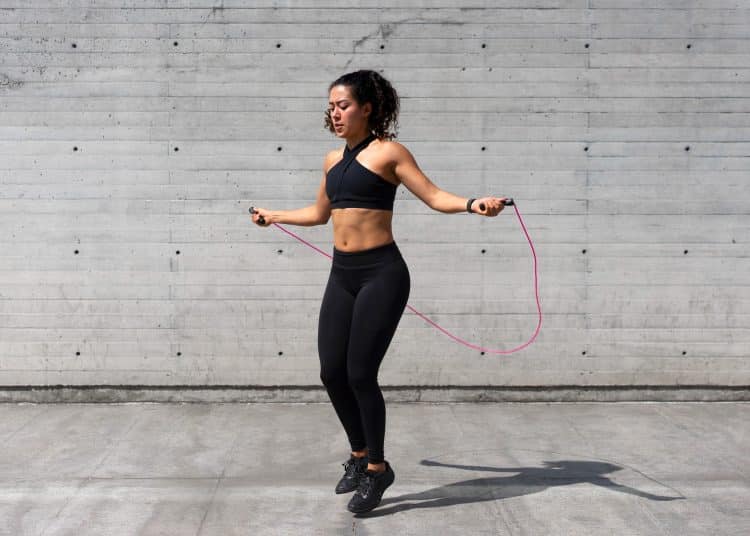Getting in a kickboxing workout several times a week is a surefire way to improve your physique aesthetics, get stronger, and improve your mental well-being. This isn’t just my opinion; it’s backed by science.
A 2014 study published in the Muscle, Ligament, and Tendon Journal showed kickboxing significantly improves various markers, including, but not limited to, strength and flexibility. (1)
Feeling drawn to these benefits but uncertain about where to begin your training? You are in the right place. I’ve designed the ultimate kickboxing workout that benefits beginners and seasoned kickboxers alike.
The Best Kickboxing Workout (3-Day Split)
Skills and striking training will be the core focus of your training. For the absolute best kickboxing workout experience (and results), I suggest three to four kickboxing training sessions per week.
Here is how I would structure a weekly kickboxing workout:
Level Up Your Fitness: Join our 💪 strong community in Fitness Volt Newsletter. Get daily inspiration, expert-backed workouts, nutrition tips, the latest in strength sports, and the support you need to reach your goals. Subscribe for free!
Day 1: Striking Technique (Bag Work and Pad Work)
Beginners must prioritize mastering the skills. This workout involves different punches and kicks and incorporates bag and pad training.
Warm-Up
| Exercise | Duration | Intensity |
| Jump Rope | 5 minutes | Moderate |
| Shadowboxing | 5 minutes | High |
Bag Training
| Exercise | Sets | Reps | Intensity |
| Jab, Cross, Hook | 2 | 20 per punch | Moderate |
| Teep, Roundhouse kick | 2 | 20 per punch | Moderate |
| Switch Kick | 2 | 20 | Moderate |
| Cross, Lead Hook combo | 2 | 10 | High |
| Jab, Rear Hook, Switch Kick Combo | 2 | 10 | High |
Finish the bag work session with a 3-minute, high-intensity freestyle shadowboxing session. Rest for five minutes before moving on to the next part of the workout.
Pad Training
| Exercise | Sets | Duration | Intensity |
| Punch Combo Speed Drill (e.g., Jab, Cross, Hook) | 3 | 90 seconds | High |
| Kick Combo Speed Drill (e.g., Teep, Switch Kick) | 3 | 90 seconds | High |
| Punch Combo Power Drill (e.g., Lead Hook, Rear Hook) | 3 | 90 seconds | High |
| Kick Combo Power Drill (e.g., Teep, Roundhouse) | 3 | 90 seconds | High |
| Freestyle Speed Drill | 3 | 120 seconds | Moderate |
Take a 2-minute rest after each drill, to catch your breath, and bring your heart rate down.
Conclude the session with 10 minutes of moderate-pace cycling.
Day 2: Defensive Techniques and Footwork Focus
Our second weekly training session will revolve around defensive maneuvers and proper footwork.
Warm-Up
| Exercise | Duration | Intensity |
| Jump Rope | 5 minutes | Moderate |
| Speed Ladder | 5 minutes | High |
Pad Training
| Exercise | Duration | Intensity |
| Defensive drills with a focus on evading and countering | 2×5 minutes (with 1-minute rest) | Moderate |
| High-intensity pad work incorporating defensive maneuvers (e.g., slips and rolls) | 2×5 minutes (with 1-minute rest) | High |
| Partner drills emphasizing footwork and defensive tactics | 2×5 minutes (with 1-minute rest) | Moderate |
| Freestyle partner drill | 2×5 minutes (with 1-minute rest) | Moderate-to-high |
Touch Drills
| Exercise | Duration | Intensity |
| Counter-attack drill (e.g., slip and hook, roll and uppercut) | 5 minutes | Moderate |
| Evasive drill (e.g., step-back, stance switch, slips, rolls) | 5 minutes | Moderate |
| Freestyle defensive drill (e.g., defense and counter-attack only) | 5 minutes | High |
After each 5-minute drill, you will take a 60-second rest. End the training session with a 10-minute jog.
Day 3: All-Around Kickboxing
The third day of the kickboxing workout will focus on implementing the skills in a combat setting.
Warm-Up
| Exercise | Duration | Intensity |
| Jump Rope | 5 minutes | Moderate |
| Burpees | 5 minutes | Moderate |
| Shadowboxing | 5 minutes | High |
Touch Drills
| Exercise | Duration | Intensity |
| Offensive drill (e.g., kick-punch combo) | 5 minutes | Moderate |
| Defensive drill (e.g., counterattacks and defensive maneuvers) | 5 minutes | Moderate |
| Freestyle balanced drill | 5 minutes | High |
Sparring
The main section of the third weekly kickboxing workout will be a 5-round sparring session. Each round is five minutes long.
The primary goal of sparring is to perform at your best and win the sparring match.
The workout ends with moderate-pace cycling.
How To Warm Up for a Kickboxing Workout?
Kickboxing requires a much more dynamic and intensive warm-up compared to some other sports or resistance training. As the goal of the warm-up is to get the entire body ready for the training session, you must do all of the following before each training session:
Jump Rope
Jumping rope activates multiple muscle groups, predominantly the calves, quadriceps, and hamstrings, which can help boost cardiovascular health.
Burpees
The goal of burpees in this warm-up is to activate your whole body so you are better prepared for the ensuing punching and kicking workouts.
I recommend doing two sets of 10, with a 90-second rest between sets.
Shadowboxing
To conclude the warm-up, you’ll do 5 minutes of shadowboxing, where you’ll throw punches and kicks with at least 60% of your power and speed.
Strength and Conditioning Training for Kickboxing
Incorporating strength and conditioning training into your kickboxing workout regimen is essential for:
- Improving kickboxing performance by building strength and explosiveness
- Boosting athletic ability
- Strength training increases tendon load capacity and ligament strength, thus lowering the risk of injuries
Your strength and conditioning training should focus on developing power and explosiveness through ballistic and rotational exercises, maximal and general strength via general resistance training, and endurance.
I suggest performing strength and conditioning training twice weekly (with an optional separate endurance-focused day), with at least a two-day break between them.
Level Up Your Fitness: Join our 💪 strong community in Fitness Volt Newsletter. Get daily inspiration, expert-backed workouts, nutrition tips, the latest in strength sports, and the support you need to reach your goals. Subscribe for free!
Here is a two-day strength and conditioning training split, implementing the four major movement patterns — pressing, pulling, squatting, and hinging.
Day 1
The first strength and conditioning training session will primarily focus on developing lower body power and explosiveness.
| Exercise | Sets | Reps |
| Trap-bar jump | 4 | 3-6 |
| Leg extension | 4 | 3-6 |
| Leg curl | 4 | 3-6 |
| Leg press | 4 | 3-6 |
| Bench press | 4 | 3-6 |
| Cable flies | 4 | 6-12 |
| Pull-ups | 4 | 6-12 |
| Back extensions | 4 | 3-6 |
Weighted jumps can boost lower body explosiveness. On the other hand, leg extensions and curls precisely target the quads and hamstrings, which are crucial for executing teeps and roundhouse kicks. Together, these exercises contribute to a well-rounded lower-body training regime.
Pro Tip: You can experiment with the weight, but on average, go for 70-80% of your one-rep max, as that would be ideal for strength-building. (2)
Day 2
Day Two will focus on building punching power through upper-body ballistic exercises.
| Exercise | Sets | Reps |
| One-arm medicine ball throw | 4 | 6-8 |
| Banded punches | 4 | 10-15 |
| Trap-bar deadlift | 4 | 3-6 |
| Hack squat | 4 | 3-6 |
| Cable rows | 4 | 3-6 |
| Lat pulldowns | 4 | 6-12 |
| Weighted dips | 4 | 6-12 |
| Hip trust | 4 | 3-6 |
Each exercise should be performed with maximum intensity. During the lifting phase, emphasize speed and power. Use slow, controlled 2-3 second descents for maximal muscle fiber stimulation.
Pro Tip: Mimic throwing a punch when performing one-arm medicine ball throws. Get into the starting position and throw the ball like you would throw a cross. Return to your fighting stance, protect your face as you would in a fight, and then go for another rep.
Day 3 (Optional)
The optional third day would be an endurance-focused 45-minute cardiovascular training session.
I recommend cycling instead of running, rope jumping, or using the stairmill, as riding a bike is kinder on the joints and connective tissues but still manages to improve general aerobic fitness and VO2 max.
Types of Kickboxing Workouts
We have utilized various kinds of kickboxing workouts over the week. Here’s what you need to know about them.
Bag Training
Bag training, also known as “bag work,” is the core of punch and kick training. It focuses on developing the striking technique, force, and power and is performed regardless of the fighter skillset.
Bag training can be done in numerous ways. Beginners should practice each punch and kick 20 times, as instructed above.
Once you progress, you can try out some kick-punch combos, such as:
- Jab, Jab, Cross
- Jab, Cross, Roundhouse
- Lead Uppercut, Rear Hook, Lead Hook
- Jab, Rear Hook, Switch Kick
- Teep, Cross, Lead Hook
Pad Training
The goal of pad training is to work on punch speed, accuracy and delivery, defensive movement, footwork, and endurance.
In addition to these sport-specific benefits, performing pad training is an excellent way to improve hand-eye coordination, general aerobic fitness, balance, agility, and almost every other aspect of physical fitness except maybe strength.
Of course, as there’s no direct contact involved, pad work is brilliant for everyone, including beginners.
Touch Drills
Unlike bag work or pad training, trainees must now throw punches and kicks at their opponent, maintaining minimal power but near-maximum speed.
The same is true the other way around. They must evade the punches and kicks, which helps work on their defense, reaction speed, coordination, etc.
Sparring
Sparring is the ultimate kickboxing workout and is usually reserved for competitive fighters. It’s a controlled, real combat scenario in which fighters practice offensive and defensive techniques and maneuvers against each other.
As sparing is done with maximum speed and approximately 60-70% power output, its primary goal is fighting skill development. It focuses on applying the techniques quickly and under pressure while perfecting timing, distancing, footwork, strategy, etc. It is also the best way to identify weaknesses.
Of course, due to its contact nature, sparring is always performed wearing protective gear and necessary equipment to minimize the risk of injury.
What are the Benefits of a Kickboxing Workout?
Here are the advantages of a kickboxing workout:
- Become healthier and happier
- Lose weight and get in excellent shape
- Get stronger, energized, and less fatigued
- Improve your cardiovascular health and fitness
- More confidence
Conclusion
As you can see, the best kickboxing workout revolves around structured combat training, utilizing various elements such as bag work, touch drills, and sparring. By mimicking the combat scenarios or practicing techniques, you can expect to progress faster.
Combining combat training with strength and conditioning workouts will help get some power behind those kicks and punches, making it a perfect one-two punch combo.
Such a holistic approach to kickboxing improves your overall health, well-being, and aesthetics. It is also a step in the right direction if your goal is to become a competitive kickboxer.
References:
- Ouergui I, Hssin N, Haddad M, Padulo J, Franchini E, Gmada N, Bouhlel E. The effects of five weeks of kickboxing training on physical fitness. Muscles Ligaments Tendons J. 2014 Jul 14;4(2):106-13. PMID: 25332919; PMCID: PMC4187584.
- Schoenfeld BJ, Grgic J, Van Every DW, Plotkin DL. Loading Recommendations for Muscle Strength, Hypertrophy, and Local Endurance: A Re-Examination of the Repetition Continuum. Sports (Basel). 2021 Feb 22;9(2):32. doi: 10.3390/sports9020032. PMID: 33671664; PMCID: PMC7927075.










